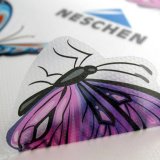Why Laminate?1. Laminating makes your printed material thicker and more robustThe transparent film applied during lamination makes the printed material thicker and more resistant to mechanical wear. Therefore, it is important to ask yourself whether your print material is likely to be wrinkle through use. If this is the case, then laminating is recommended. There are several advantages when you choose to laminate. For example, you can apply a laminated sticker more easily, there is less chance of air inclusions under the sticker, and the sticker is less likely to wrinkle. This also makes the sticker easier to remove if you want to do so in the future. 2. Laminating protects against UV radiationIf your printed material is exposed to many environmental factors, such as the sun, there is a high risk of discoloration. UV-B rays cause the ink to fade. Laminating your work with protective films with integrated UV protection slows down or prevents this process and ensures that your prints retain their beauty much longer. 3. Laminating protects against moisture and dirtLaminating your work also prevents moisture from penetrating your printed materials and dirt, e.g., from greasy fingers, from sticking to them. This not only protects your prints from water damage, for example, but also makes them easy to clean. This is very handy when you are dealing with outdoor applications. 4. Laminating protects against damageTears and creases do not stand a chance when your work is properly laminated. By using a scratch-resistant material, you can provide your printed material with a scratch-resistant layer. This is often applied to print media for display panels of pop-up systems. These panels have to endure a lot during transport, assembly, and disassembly. It, therefore, makes sense to laminate frequently used panels to provide better protection.
5. Laminating gives a luxurious appearanceLaminating, also known as finishing, is a finishing technique that gives printed material a luxurious and characteristic appearance. Laminating makes the paper appear and feel firmer, making the quality appear (and be) better. A wide range of finishes is available, ranging from matt, satin, glossy and high gloss. Depending on the application of the printed material, you can choose the most suitable finish. Using glossy laminates, for example, colors come out more powerfully. And the use of matte films prevent disturbing light reflections, for example, in photo posters. 6. Laminating increases the lifespan of printed materialsThe protective layer of the laminate also increases the lifespan of your printed material. You have to keep in mind that prints that are not protected against mechanical or environmental influences have a limited lifespan. Therefore, you can say that applying a protective film extends the life of prints and secures their value. A not unimportant finishing touch!7. Laminating provides your printed material with special propertiesIn addition to the standard laminating films mentioned above, there are also laminating films with unique properties. For instance:
|
-
Consumables
-
Sun Protection








- Curtain Production
- Matic M21 Cutting Machine
- EOS Curtain sewing automation
- SEWING-Matic Nyx Overlock sewing system
- SEWING-Matic NYX Ultimate Curtain Sewing System
- SEWING-Matic Nyx Compact
- SEWING- Matic Nyx Top Tape
- SEWING-Matic Nyx Roman
- CUTTING- Matic Olympo Curtains
- CUTTING- Matic Helios Plus Laser
- CUTTING- Matic Flexicut Linear Cutter
- IRONING-Aura Ironing System
- HANDLING-Matic Inspector
- CUTTING-Matic Sonomatic
- STORAGE Matic Atlas H
- Plastgrommet Curtain Station
- Olympo Curtain Inspection
- Printers
-
Roll Cut






-
Cutting






- Digital
- Elitron Spark C
- Elitron Spark F
- Elitron Kombo SD+
- Elitron Kombo TH
- Elitron Kombo SDC+ 3.2
- Elitron Klick Print Management Software
- Elitron Seeker System explained
- Elitron Custom Cutting details
- Matic Flexicut
- Flexa Miura
- Flexa Miura Plus
- Flexa Miura Plus HD
- Flexa Miura II 1650 Wallpaper
- Flexa Extrim
- Flexa Katana
-
Laminators



- CWT Applicator Tables
- OUR GUIDE TO Buying a CWT Flatbed Applicator, Lamination Table or Sign Applicator
- CWT ADVANTAGE FLATBED APPLICATOR TABLE
- CWT REGULAR FLATBED APPLICATOR TABLE
- CWT PREMIUM FLATBED APPLICATOR TABLE
- CWT Linear Cutter
- CWT Linear Cutter Pro
- Traffic Signs
- Cutting Mat Clear Blue Frosted
- Cutting Mat Clear Blue Standard
- Cutting Mat Anti-Static
- CWT Original Cutting Mats
-
Finishing




- Eyelet Machines
- Hand Presses for Eyelets
- Plastrommet Semi-automatic Queen & SpeedQueen
- Plastgrommet Crossover
- Plastgrommet Evolution Automatic eyeleter
- Plastgrommet Autocross Automatic
- Plastgrommet Multipress Automatic
- Plastgrommet Finishing Station
- Plastgrommet Roll to Roll Range
- Plastgrommet All in One
- Plastgrommet Clear Plastic Recyclable Eyelets
- Forsstrom HF eyelet
- Sewing Machines
- Matic CRONOS GO
- Matic CRONOS SEWING SYSTEM
- Matic CRONOS 4.0
- Matic Nyx Overlock
- Matic Nyx Ultimate Curtain Sewing System
- Matic ORION SEWING SYSTEM
- Matic Hercules Awning Sewing System
- Matic Nyx Compact
- Matic Nyx Top Tape Sewing System
- Matic Nyx Roman
- Recyclable Thread
- Recyclable Keder SRK
- Cotton Cones Dual purpose
- Cotton bonded nylon
- White Keder
- Translucent Blue Keder
- Self Adhesive Recyclable
- Silicon Keder
- Hammer In Keder Silver
- Hammer in Keder Clear
-
Racks & Lifters

- Plastgrommet Media Handling
- PLASTGrommet Bull Rack 1620
- Plastgrommet BullRack MAX
- PLASTGrommet BullRack Cutter
- PLASTGrommet BullRack XXL
- PLASTGrommet Jumbo Rolls Transporter
- PLASTGrommet Mobile 12
- PLASTGrommet Mobile 16
- PLASTGrommet Easy Rack
- PLASTGrommet Wallrack
- PLASTGrommet Multi Rack
- PLASTGrommet Rolling Rack
- PLASTGrommet SwivelRack
- PLASTgrommet Roll Clips
- PLASTGrommet Compact Lifter
- PLASTGrommet Compact e- Lifter Lite
- PLASTgommet e-lifter Pro
- PlastGrommet RollMax Lifter
- PlastGrommet RollMax e- lifter
- Used & Ex-Dem
- FESPA 2025 Partners

